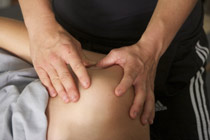Deep Tissue Massage
The History of Deep Tissue Massage
 Experts believe that the ancient Egyptians were the first to use Deep Tissue Massage (Ury, 2009). However, its modern history can be followed back to the mid-19th century in Canada. Physicians at that time employed this modality to deal with different medical conditions, for example, whiplash (Ury, 2009).
Experts believe that the ancient Egyptians were the first to use Deep Tissue Massage (Ury, 2009). However, its modern history can be followed back to the mid-19th century in Canada. Physicians at that time employed this modality to deal with different medical conditions, for example, whiplash (Ury, 2009).
In the late 1800s, Deep Tissue Massage was introduced to the United States (Ury, 2009). It was not until Therese Phimmer established rules for and formalized this technique in her book called "Muscles:Your Invisible Bonds in 1949 that this technique became popular in the U.S. (Ury, 2009). Since then, Deep Tissue Massage has been used by more and more sports medicine practitioners and muscular therapists to address "soft tissue injuries and chronic pain" (Ury, 2009).
What Is Deep Tissue Massage?
 Deep Tissue Massage intends to break up adhesions and enhance overall flexibility by manipulating the deeper layers of the muscles' underlying connective tissue" (fascia) (Ury, 2009). The movements used in Deep Tissue Massage are similar to those in traditional Swedish Massage (Ury, 2009). However, the pressure used in Deep Tissue Massage is "more focused and intense" (Ury, 2009) and the movement is at a slower pace (Wong, 2012) than in a traditional massage.
Deep Tissue Massage intends to break up adhesions and enhance overall flexibility by manipulating the deeper layers of the muscles' underlying connective tissue" (fascia) (Ury, 2009). The movements used in Deep Tissue Massage are similar to those in traditional Swedish Massage (Ury, 2009). However, the pressure used in Deep Tissue Massage is "more focused and intense" (Ury, 2009) and the movement is at a slower pace (Wong, 2012) than in a traditional massage.
Note: Adhesions (or "knots") refer to "bands of painful, rigid tissue in muscles, tendons, and ligaments" (Wong, 2012). They can impede circulation, limit movement and cause pain and inflammation (Wong, 2012).
Alan Repas is a professional structural energetic therapist in Massage Health Center in Gainesville, Florida. He has been practicing acupuncture and Swedish Massage for many years and has specialized in deep tissue massage for two years. Here he shares with us his experience with this modality:
Health Benefits
 Deep Tissue Massage works beneficially for pain and stiffness relief which is associated with sports injuries, whiplash, osteoarthritis, muscle spasms, fibromyalgia and strain injuries (Ury, 2009). It is also effective in releasing toxins from muscles and improving the circulation system in the body (Mamas Health).
Deep Tissue Massage works beneficially for pain and stiffness relief which is associated with sports injuries, whiplash, osteoarthritis, muscle spasms, fibromyalgia and strain injuries (Ury, 2009). It is also effective in releasing toxins from muscles and improving the circulation system in the body (Mamas Health).
